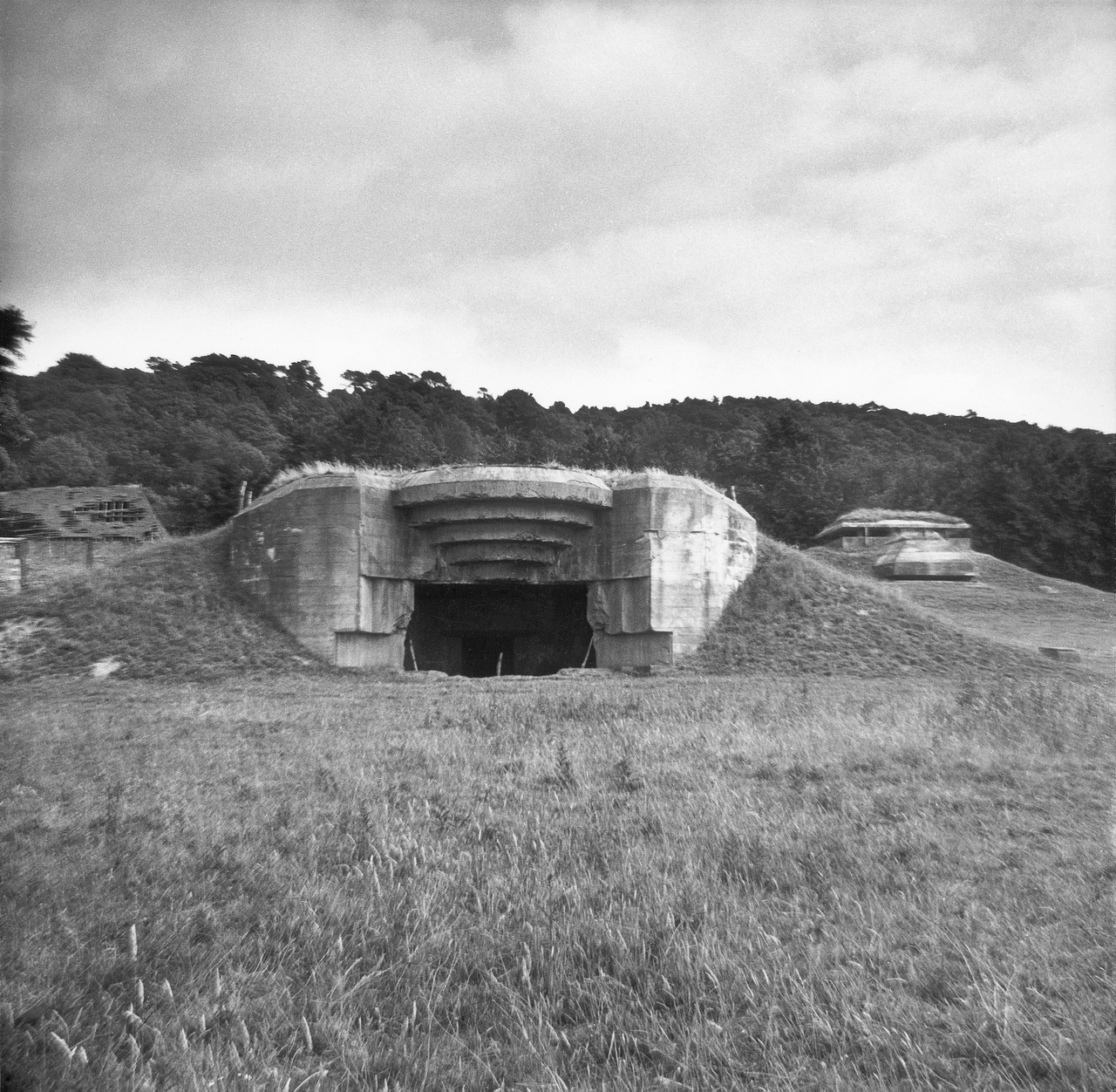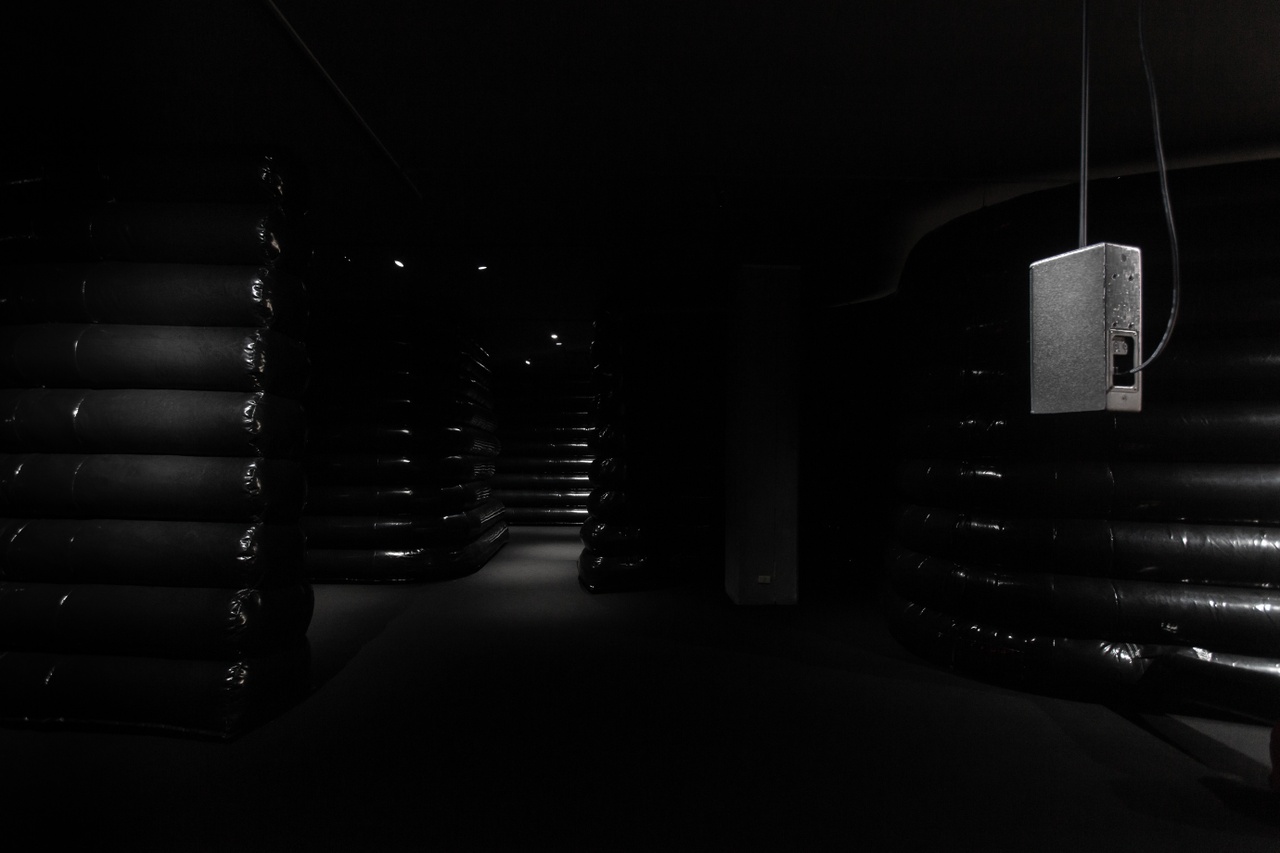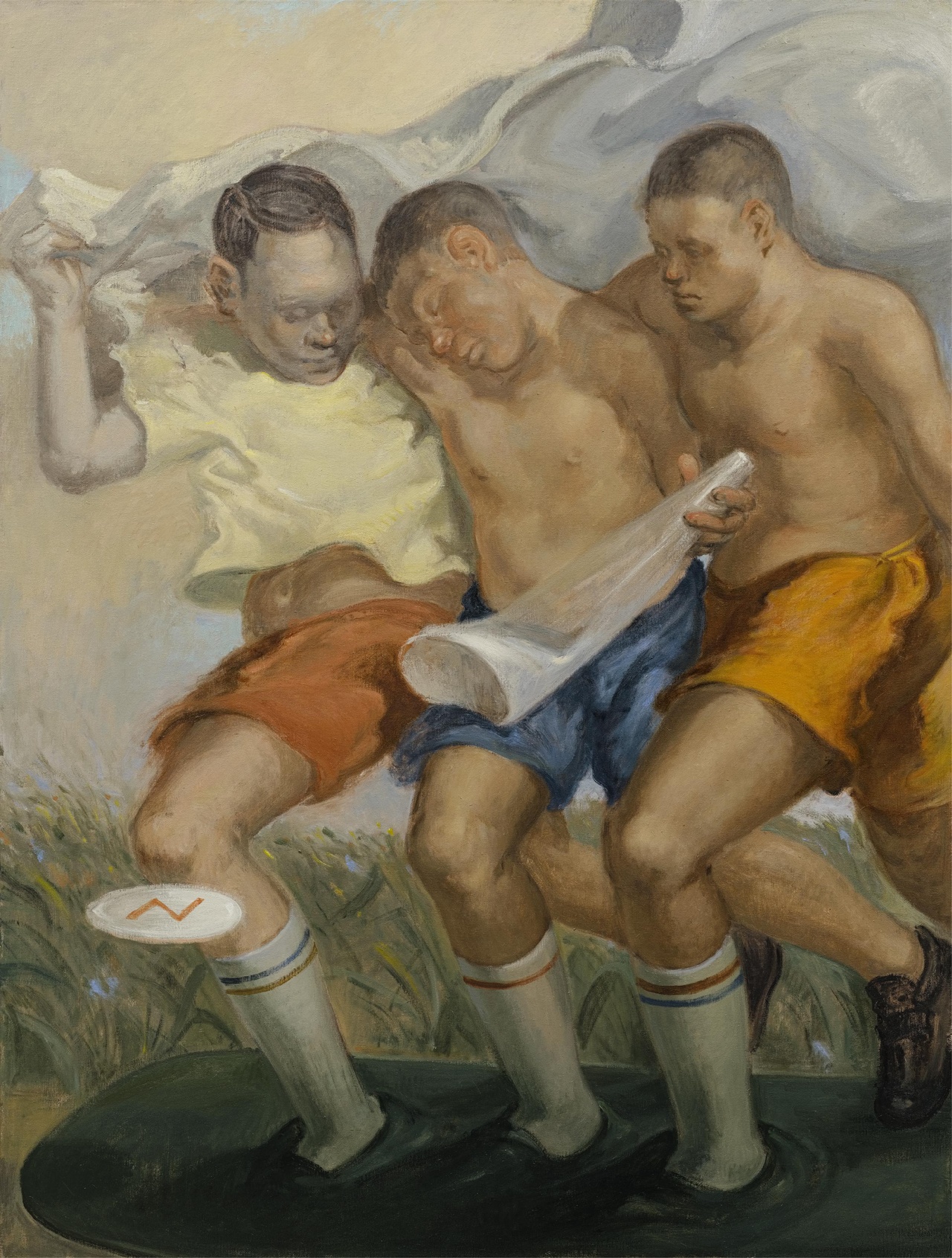ALMOST CONCEPTUAL Luise Mörke and Tobias Rosen on the 13th Taipei Biennial

Paul Virilo, “Bunker Archeology,” 1958–65
Formidable concrete shells, relics of a past war, guard the entry to the thirteenth Taipei Biennial. Photographed in the 1950s and ’60s by architect and theorist Paul Virilio, these black-and-white images of World War II bunkers in Normandy set the mood for the exhibition: shades of gray and dim lighting create a taciturn, austere impression, punctuated by the subtle brutality of disturbing imagery as well as grating and screeching sounds from nearby installations and video works. As objects of aesthetic thinking, these obsolete bunkers also configure the exhibition’s relationship to theory. Virilio, known foremost for his writing on the capacity of speed to compress space, is made present not through ideas but by structures that encapsulate a rich density of unarticulated thought. Theory lingers in the back at the Taipei Biennial, like a guardian angel whose presence cannot be verified. Concepts are neither the driving force nor the argumentative endpoint for the curatorial team, Freya Chou, Reem Shadid, and Brian Kuan Wood.
“Small World,” the theme of the biennial, relates to globalization, the planetary, or the minor, [1] but does not entail an abstract epistemological architecture of its own. The exhibition statement explicitly links the title to the experience of spatial compression and feeling of isolation that became nearly universal during the Covid pandemic, which the curators deem “both a promise and a threat.” [2] As a seemingly obvious description of something self-contained, concrete, and limited in scope, “Small World” is, we suggest, at most an almost-concept: an intuition that reaches toward a conceptual understanding of emerging social relations. An emphasis on experience and feelings, combined with a reluctance to enclose artworks in interpretative frameworks borrowed from Theory, differs from previous editions of the biennial, whose curators included theorists Bruno Latour (2020) and Nicolas Bourriaud (2014) as well as Anselm Franke (2012). This shift indicates a wider weariness of “theory” as an exclusive intellectual brand marked by an alignment with Euro-American hegemony. In 2022, “documenta fifteen” privileged accessibility and experiences of collectivity, breaking with the heady analytical approach of the preceding edition in 2017. Berlin’s Haus der Kulturen der Welt, where Franke was previously head of visual arts and film, underwent a similar transformation, incorporating experience, ritual, and enchantment into its program.

Jacqueline Kiyomi Gork, “Not Exactly (Whatever the New Key Is),” 2017–ongoing
However, artworks in the Taipei Biennial do, in fact, mimic forensic analysis, draw on the legacy of minimalism, and investigate apparatuses as networks of perceptual, governmental, and technocratic power. But instead of exclusively analyzing technological infrastructures and geopolitics, the curation also tracks the feelings and inchoate thoughts that resonate within the folds of these systems. Nadim Abbas’s commissioned installation Pilgrim in the Microworld (2023), for instance, looks like microchip circuitry massively scaled up, or a sprawling industrial site scaled down to model. Stainless steel containers are filled with sand, an essential element for the semiconductor industry, and neon green liquid, offset by the room’s cold blue lighting, is reminiscent of an urban landscape in a science fiction film. Abbas’s work speaks to quandaries of both the larger geopolitical order and those afflicting microscopic infrastructures that undergird contemporary life. Taiwan’s dominance in the production of microchips gives the small island an importance in the global economy, sometimes seen as an insurance policy against Chinese invasion. In addition to charting routes of data and capital, close observation reveals that Abbas’s work is also afflicted by entropy: the rectilinear sandcastles crumble, a film of dust settles on the green water. Pilgrim thus evokes numerous feelings, such as the irritation with flaws, the tedium of maintenance, and worry about the fragility of existing conditions.
Abbas’s installation is intensified by its proximity to Patricia L. Boyd’s video work Operator (Refinanced II) (2017–ongoing), cleverly compressed into a corner behind the room’s stairwell and a custom-made drywall. This arrangement forces viewers into uncomfortable proximity to the imposing screen, which shows the movements of Boyd’s camera anxiously scanning the floor of a black box theater. Exposed to abrasive sounds and distressing fluctuations of light, stepping into this narrow corridor feels like being on the inside of the apparatus itself. The viewer thus merges with the machinic system, without critical distance to form an image of its operations.
Upstairs, the black box is a space to actually walk into: Jacqueline Kiyomi Gork’s tumescent inflatable walls fill a pitch-black room. While Boyd’s video is hard, technical, and confrontational, Gork’s Not Exactly (Whatever the New Key Is) (2017–ongoing) offers a squishy, intestinal counterpart that operates, more than any other work in the biennial, on a bodily and affective level. Visitors hesitated to go deeper into the cavernous room, afraid perhaps of being swallowed by the darkness. Once inside, they entered a cycle of mounting threat, tension, and release (humorous or otherwise) that accompanied the choreography of the rising and falling walls. As Gork’s wobbly, maze-like architecture deflates, the limp pile of plastic evokes the mirror image of the let down of a failed utopia. In one case, a promise tips into disappointment, in the other, a threat into something pitiful.

Chen Ching-Yuan, “Slip of the Tongue,” 2022
Close-up photographs of urban anomalies taken by Japanese conceptualist Genpei Akasegawa span a wall on the first floor. They home in on nonsensical structures, tools without functions, or traces of aborted plans, grouped by the artist under the term “Hyperart Thomasson,” named after the American baseball player Gary Thomasson, who was signed by a Japanese team in the early 1980s for a large sum of money but spent most of his tenure on the bench. Akin to how “Small World” is an almost-concept, these authorless oddities are almost conceptual artworks. Some of them, such as a doghouse haphazardly modified to fit a large gas container, suggest a cynically humorous outlook on imperfect attempts at homemaking. Others are situated at the threshold of meaning, like a bundle of steel letters awaiting assembly into a word, or a wall composed of gray and white rocks that almost form a pattern. These images document the frustrations of a task or need coming up against material constraints. As small failures of coherence, they also open the seams of the everyday, inserting imaginative agency into a built environment that predetermines behavior and experience. Both Akasegawa’s “Hyperart” and Gork’s squishy, deflated walls toy with rigid structures by focusing on cracks and fissures or drawing out the dramatic, sometimes comic performativity of what seems set in stone.
Exhibited as a hinge between Abbas’s Pilgrim and Akasegawa’s photographs, Chen Ching-Yuan’s paintings draw to an eerie standstill, resonant with the exhibition’s recurrent theme of a suspension between the building and unbuilding of structures. Chen shows formations of bodies, at once listless and in action, whose purpose seems to have receded into an unreachable past. Three boys, painted in washed-out colors, walk arm in arm underneath a billowing white banner. They faintly recall men at work, choreographed athletes, or protesters marching toward a common goal – the trade and stock of socialist realism, though here optimism and aspiration have faded. Exhibited alongside these figurative scenes are smaller paintings of bricks, the subdued plainness of their color palette enriched by surface fracture. During the Covid lockdown in Paris, Chen magnified online imagery of various protests around the world, choosing to paint the bricks as inert, inscrutable things rather than endowing them with political agency. The result is a displacement of their constructive value by a drained, recalcitrant presence. Like the “Small World,” these paintings become spaces of ambivalent politics. They elude subsumption to universality but also carry on toward the incessant erection of nonsense.
Writing into the lacunae of structuralism, Raymond Williams aimed to describe what is “present and moving, all that escapes or seems to escape from the fixed and the explicit and the known,” coining the phrase “structures of feeling.” [3] Within his essay of the same name, the term remains, by necessity, without clear contours. The stakes, however, are explicit: to loosen the analysis of social relations to include a consideration of forces which are active but not yet articulable as concepts. The rhetorical effect of Williams’s turn of phrase stems from its contradictory pull between something large and overarching and something small and personal. It entails both the presence of felt structures, experienced but unnamed, and the structural nature of feelings, such as the stress and anxiety caused by economic insecurity. In a comparable way, the Taipei Biennial draws out what emerges from the infrastructures and apparatuses of contemporary capitalism in excess of how it would be framed by ideological critique. In the face of the “Small World,” one may feel frustration or humor in reaction to malfunctions of the urban system, imaginative potential and melancholic loss when faced with a sealed portal, or the claustrophobia and intimacy produced by a contained environment.
“Small World, ” 13th Taipei Biennial, Taipei Fine Arts Museum, November 18, 2023–March 24, 2024.
Luise Mörke is a critic and writer. She lives in Cambridge, MA, and Berlin.
Tobias Rosen is an art historian, researcher, and writer living in Princeton, New Jersey.
Image credit: 1. Courtesy of Sophie Virilio and Taipei Fine Arts Museum; 2. Courtesy of the artist and Taipei Fine Arts Museum; 3. Courtesy of the artist, Foundation Croÿ-Roeulx and Taipei Fine Arts Museum
